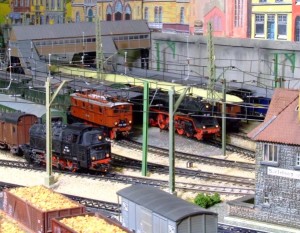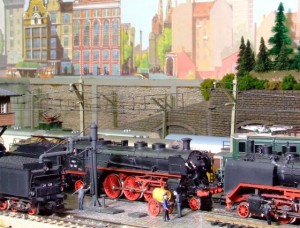Dale Kraus
Speed Matching
Before getting into consisting, one more step needs to be taken. To have a smoothly running consist, all of your locos should run at (about) the same speed for a given speed step. Exact matching may be theoretically possible, but is far too fussy for practical implementation. What we really need is for the locos to start together and run realistically without excessive “bucking.” Unless they all run at about the same speed the faster locos will drag or shove the slower ones, decreasing the tractive effort and causing the faster locos decoders to run hot. This is not a good idea.
To accomplish speed matching we need to use only three CV’s: CV2 (starting speed), CV5 (top speed), and CV6 (mid range speed). Assuming you have already slowed down your locos (DCC Demystified-3), follow the steps below for a “good enough” solution.
First, select the loco that starts at the lowest speed step (usually step 2). This will be used as a standard for comparing the others. Place this loco on a three-foot long (minimum) test track. This can be on your layout, but I prefer a separate track. Take another loco and temporarily give it the same address as the “standard.” Place the second loco on the test track about six inches from the standard, and start the locos. Adjust CV2 on the second loco until they both start at the same speed setting. To avoid having to take the “standard” loco off the track, simply tip it up on the far rail and place a sheet of paper under the wheels on the near side. Do this step for all your locos. Just doing this step will cure 80% of the problems that occur during consisting if you have already used CV’s 5 and 6 to slow down your steel steeds. If you are going to operate your RR before finishing the speed matching be SURE to return all locos to their primary addresses!!
That’s enough for one night … go take a break.
The next time you get ambitious, take the “standard” loco and one of the others and place them on your main line, about a foot apart. (If necessary, change the address of the second loco again.) Start ‘em up and go quickly to main line speed. Note if the second loco lags behind or catches up. Use the paper under the wheels trick to isolate the standard loco and, using Program on the Main, adjust CV5 on the other up or down. Check the two together again and change CV5 as needed. Repeat this drill with the other locos. Note here that they will NEVER run exactly at the same speed. Just get it close, as minor differences will not matter. Now, set CV6 to the mid-point between CVs 2 and 5. That will do it.
Before you quit, remember to reset the addresses of all your locos.


